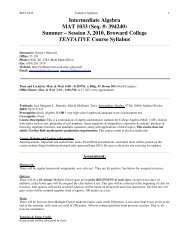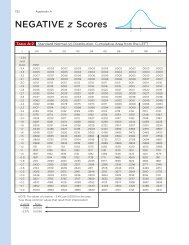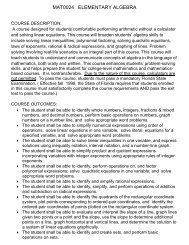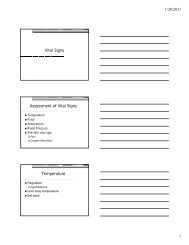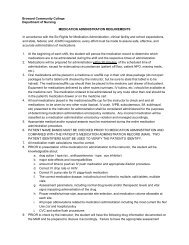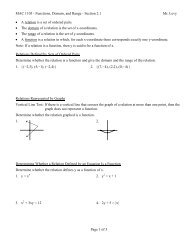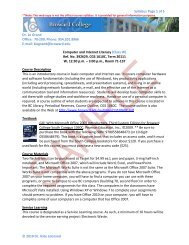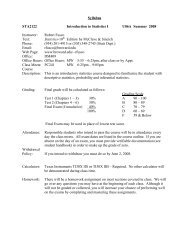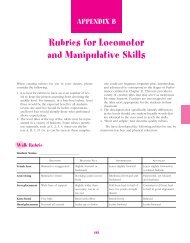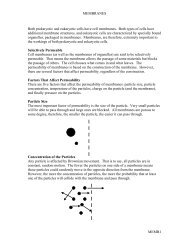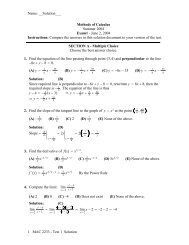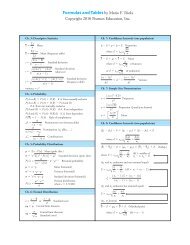MAC 1147 Trigonometry & Precalculus Algebra Problem Set Due ...
MAC 1147 Trigonometry & Precalculus Algebra Problem Set Due ...
MAC 1147 Trigonometry & Precalculus Algebra Problem Set Due ...
You also want an ePaper? Increase the reach of your titles
YUMPU automatically turns print PDFs into web optimized ePapers that Google loves.
<strong>MAC</strong> <strong>1147</strong> <strong>Trigonometry</strong> & <strong>Precalculus</strong> <strong>Algebra</strong><strong>Problem</strong> <strong>Set</strong><strong>Due</strong> Friday, November 12 th , at 9:30 AMDirections: You will work on these in groups of three or four students. Groups maynot consult with other groups’ members regarding these items. The only consultationpermitted is with the professor of the course. All work must be clear, complete, andconcise. Your work and answers for each section must be independent of thissheet—a person reading your work should not have to consult this sheet todetermine what you are doing or what you are trying to find. All final answersmust be clearly indicated as such. All graphs are to be manually drawn on graphpaper and are to be large, neat, and clear. You will be graded on presentation as wellas correctness—neatness and organization counts! Unless otherwise indicated giveexact answers, or give answers correct to three significant figures as appropriate. Aclean copy of this sheet will be stapled to a single copy of your group’s work as acover sheet, and the work is due on Friday, November 12th, at 9:30 AM. Workturned in after this deadline will receive at least one letter grade deduction, or maynot be accepted at all and each member will receive a score of zero for the item.Group Members’ Names:Group Members’ Names5 4 3 21) For the function f ( x) = 2x+ 3x−16x− 24x−18x+ 23, find ALL the solutions, real andimaginary, of the equation f ( x) = 50 . (Be careful—note that this is NOT the equation ( x) = 0f !)Use the techniques from Chapter 4 (e.g., Descartes Rule of Signs, the Rational Zero Theorem, theRemainder and Factor Theorems, etc.) to do this.3x − 8= . Show any asymptotes (vertical, horizontal, or slant) with dashed22x+ 4xlines and label each asymptote with its equation.2) Graph the function f ( x)c3) Population growth can be modeled using a function of the form P = 1 −bt+ ae, where a, b, and c arepositive constants, and t is time.a) Suppose the function P = 1,000,000−0.t1+9,999e, which gives the population in year t of the spectacled4meerdog on a heretofore undiscovered continent.i) Find the value of P when t is zero.ii) What maximum value does P tend toward as t grows very large? At what value of t is Pwithin 1 unit of this maximum value?iii) Use the information from (i) and (ii) to determine an appropriate window and graph P so that itfills one side of a full sheet of graph paper.iv) Determine the values of P when t = 20, 50, and 100.b) Explain how such a function better represents population growth rather than a function in the formktP = P0e .1,000,000c) Investigate the graphs of other functions of the form P =by taking different positive−bt1+9,999evalues of b. What effect(s) (visually speaking) does the choice of b have on the graph of P? (Becareful—the rule has a built in negative sign. For example, if b = 2, the rule will beP 1,000,000= .) Show at least four small sketches of graphs with different values of b that− t1+9,999e2support your claims about the effect b has on the graph.
<strong>MAC</strong> <strong>1147</strong> <strong>Problem</strong> <strong>Set</strong> Page 24) Find the partial fraction decomposition ofdenominator.)x53x− 5x44+ 2x+ 2x23+ 20x+ 32−10x+ x − 5. (Hint: x = 5 is a zero of the5) A nautical mile equals the length of arc subtended by a central angle of 1 minute (i.e., one-sixtieth[160]of a degree) on the surface of the earth at the equator. Suppose the radius of the earth is 3960(statute) miles.a) Using only the information above (that is, do not consult any outside source or reference to findinformation about the answer), express 1 nautical mile (n.mi.) in terms of ordinary, or statute,miles (mi.). Give answer both exactly and correct to three decimal places.b) Use your result from part (a) to express 1 statute mile in terms of nautical miles. Give answerboth exactly and correct to three decimal places.c) Look up the number of feet in a statute mile. Using the exact-value results above, calculate thenumber of feet in a nautical mile. Which one is longer, a statute mile or a nautical mile? By howmany feet? Give answer both exactly and correct to three decimal places.6) If an object is projected at an angle θ (relative to the horizontal) from ground level with an initial2v0sin( 2θ )velocity v0, the formula x = gives the horizontal distance (or range) x traveled by thegv2sin 20θobject, and the formula y = gives the maximum height y of the object achieved by the2g2object during its flight. The constant g is acceleration due to gravity (either 9.81 m /sec or232 ft /sec , depending on the units of measure being used). Use 1 foot = 0.3048 meters for unitconversions of length. Consider the two configurations:Configuration I: angle of 42° to the horizontal with an initial speed of 130 meters per secondConfiguration II: angle of 50° to the horizontal with an initial speed of 420 feet per seconda) Which configuration results in the farthest range (i.e., farthest horizontal distance from the startingpoint)? How many feet (to the nearest hundredth of a foot) farther is this flight?b) Which configuration results in the highest flight? How many meters (to the nearest hundredth of ameter) higher is this flight?



